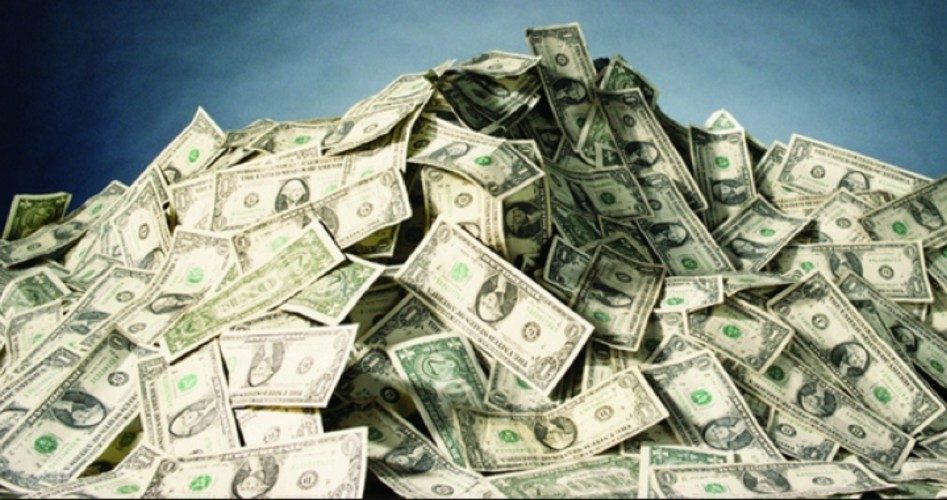
As Congress once again prepares to increase the government’s borrowing authority above the already-absurd $18.1 trillion cap and avoid a federal default, the time to call lawmakers out on the carpet over the federal spending is long overdue. According to the Monthly Treasury Statement, released on September 11, the federal government received a record $2 trillion ($2,883,250,000,000) in tax revenues in the first 11 months of fiscal 2015, approximately $19,346 for every person in the country who had either a full-time or part-time job in the same period. Why then does the spending cap need to be raised once again?
CNS News answers that question rather simply: “Despite the record tax revenues of $2,883,250,000,000 in the first eleven months of this fiscal year, the government spent $3,413,210,000,000 in those eleven months, and, thus, ran up a deficit of $529,960,000,000 during the period.”
Now will skeptics admit that the United States does not have a revenue problem, but a spending problem?
Most of the spending went to Social Security, which amounted to $812 billion; to the Pentagon, which received $536 billion; and to Medicare, which took in $501 billion. Another whopping $235 billion paid just the interest on government debt.
Nothing good could come out of this sort of spending. According to the CATO Institute, the current federal debt held by the public is over $13 trillion, which is approximately $107,000 per household in the United States.
In a report entitled “Washington’s Largest Monument: Government Debt,” CATO further notes that financing that debt through tax collection is futile since much of the revenue collected goes toward subsidy and benefit programs, disincentivizing Americans from wanting to participate in the workforce and from accumulating any sort of savings. Economist Edgar Browning looked at the effects of federal tax and spending programs and determined that “it costs taxpayers $3 to provide a benefit worth $1 to recipients.”
And yet the Obama administration has showed no qualms about raising taxes on the American people. In 2012, the top income tax rate was increased from 35 percent to 39.6 percent, and in 2013, ObamaCare taxes on dividends, interest, capital gains and royalties took effect.
The Obama administration also continues to pledge massive amounts of taxpayer dollars to welfare and social services programs. Forbes outlined in 2012 just how much the Obama administration has expanded the welfare society.
The Obama administration’s reliance on Keynesian economics continues to result in increased federal spending and deficits.
And financing debt through further borrowing leads to even more spending by the government, notes the CATO Institute, because borrowing “makes programs appear to be ‘free’ to citizens and policymakers.”
Furthermore, any additional unforeseen circumstances such as military efforts or recessions could serve only to increase the already sky-high deficits.
Some economists have scoffed at concerns over the deficit. Paul Krugman, for example, a New York Times columnist and propagator of Keynesian principles, has stated that the federal debt is not to be feared because it’s ultimately money “we owe to ourselves.” And in a bizarre move, Krugman grandly announced in 2013 that the deficit problem was “mostly solved.”
But the Congressional Budget Office offers a very different perspective on the subject, warning, “A large and continuously growing federal debt would…increase the likelihood of a fiscal crisis in the United States.”
Last month, CBO Director Keith Hall warned, “The growth in debt is not sustainable…. Obviously, you can’t predict tipping points, but at some point this becomes a problem.”
Likewise, a study by Harvard professors Carmen Reinhart and Ken Rogoff noted, “Counties, banks, individuals and firms take on excessive debt in good times without enough awareness of the risks that will follow when the inevitable recession hits.” They added that government debt “is certainly the most problematic, for it can accumulate massively and for long periods without being put in check by the markets.”
Obama’s critics do not believe that the deficit crisis is a result of a lack of “awareness of the risks,” however. The notion of increased spending, entitlements and debt to overwhelm the system comes from a page right out of the Cloward-Piven strategy, to which President Obama subscribed during his days at Columbia University.
In a 2013 Forbes article entitled “Deconstructing Obamanomics: What is the Real Goal?,” Bill Frezza, an MIT graduate and a fellow at the Competitive Enterprise Institute, as well as a Boston-based venture capitalist, considers “the horrifying possibility — unlikely as it might sound — that precipitating an existential crisis in order to bring about radical change has been Obama’s underlying agenda all along.”
Frezza writes,
Suppose, just for the sake of argument, that the series of deeper and deeper crises the nation is experiencing are not unintended consequences of failed policies but were the primary goal all along…. Suppose [Obama] is methodically executing the infamous Cloward-Piven strategy — which, if it is not succeeding in its objective of totally remaking America, you sure couldn’t tell by looking at the results.
And yet Congress stands poised to once again raise the debt ceiling. And whether the ever-increasing deficit is the result of an insidious Cloward-Piven strategy or more innocuously the result of simply bad Keynesian economic policies, the outcome remains the same for the American people: dire.



